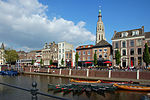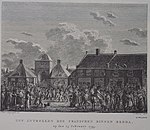The siege of Breda of 1624–25 occurred during the Eighty Years' War. The siege resulted in Breda, a Dutch fortified city, falling into the control of the Army of Flanders.
Following the orders of Ambrogio Spinola, Philip IV's army laid siege to Breda in August 1624. The siege was contrary to the wishes of Philip IV's government because of the already excessive burdens of the concurrent Eighty and Thirty Years' wars. The strategically located city was heavily fortified and strongly defended by a large and well prepared garrison of 7,000 men, that the Dutch were confident would hold out long enough to wear down besiegers while awaiting a relief force to disrupt the siege. Yet despite the Spanish government's opposition to major sieges in the Low Countries and the obstacles confronting any attack on such a strongly fortified and defended city, Spinola launched his Breda campaign, rapidly blocking the city's defences and driving off a Dutch relief army under the leadership of Maurice of Nassau that had attempted to cut off the Spanish army's access to supplies. In February 1625, a second relief force, consisting of 7,000 English troops under the leadership of Horace Vere and Ernst von Mansfeld, was also driven off by Spinola. After a costly nine-month siege, Justin of Nassau surrendered Breda on 2 June 1625. Only 3,500 Dutchmen and fewer than 600 Englishmen had survived the siege.The siege of Breda is considered Spinola's greatest success and one of Spain's last major victories in the Eighty Years' War. The siege was part of a plan to isolate the Republic from its hinterland, and co-ordinated with Olivare's naval war spearheaded by the Dunkirkers, to economically choke the Dutch Republic. Although political infighting hindered Spinola's freedom of movement, Spain's efforts in the Netherlands continued thereafter. The siege of 1624 captured the attention of European princes and, along with other battles, played a part in the Spanish army regaining the formidable reputation it had held throughout the previous century.
In the latter stages of the combined Eighty and Thirty Years' wars that had greatly strained Spanish resources, Breda was lost to the Dutch under Frederick Henry after a four-month siege. In the 1648 Treaty of Westphalia that ended the Thirty and Eighty Years' wars, it was ceded to the Dutch Republic.











